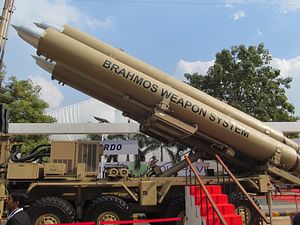The Indian Ministry of Defense’s (MoDs) Defense Acquisition Council (DAC), chaired by the country’s defense minister, Rajnath Singh, cleared the procurement of an unknown number of long-range Next Generation Maritime Mobile Coastal Batteries (NGMMCB, Long Range), armed with BrahMos supersonic cruise missiles, on August 8, according to local media reports.
The DAC did not reveal an induction schedule or where the new weapons systems will be deployed. According to IHS Jane’s Defense Weekly, the NGMMCBs could be stationed at INS Trata, a missile battery base of the Indian Navy at Mumbai, tasked with the coastal defense of Maharashtra and Gujarat. The trade publication also revealed that acquisition costs for the two NNGMMCBs are estimated at around $140.37 million, although the MoD did not publicly disclose the number of batteries to be procured.
The BrahMos, a derivative of the Russian-made P-800 Oniks over-the-horizon supersonic anti-ship cruise missile with a range estimated at between 300 to 400 kilometers, is considered be one of the world’s fastest cruise missiles currently in operational use.
The Indian MoDs research branch, the Defense Research Development Organization (DRDO), last test fired a BrahMos anti-ship variant at the Integrated Test Range (ITR) in Chandipur along the coast of Odisha in June. The month, the Indian Army test launched a BrahMos surface-to-surface variant from Car Nicobar Island, the northernmost of the Nicobar Islands.
While the land-launched and sea-launched variants of the BrahMos are already in service with the Indian Army and Navy. The missile’s air-launched variant is expected to become operational by the end of this year with the Indian Air Force (IAF), as I wrote previously:
An air-launched variant of the BrahMos is expected to become operational this year. Notably, the Indian Air Force (IAF) test fired an air-launched BrahMos-A supersonic cruise missile from a Sukhoi Su-30MKI fighter on May 22. The missile was first flight tested from a Sukhhoi Su-30 in November 2017 over the Bay of Bengal.
Two IAF Su-30 MKI fighters have been converted to carry the air-launched variant of the BrahMos. A total of 40 Su-30 MKIs are expected to be retrofitted to carry the 2.5-ton supersonic air-to-surface cruise missile. Next to others, upgrades to the aircraft will include reinforcing the Su-30MKIs undercarriage and hardening its electronic circuitry.
To expedite the mass production of the BrahMos, Indian missile maker Larsen & Toubro inaugurated a new production line for BrahMos transport launch canisters in Vadodara in the western state of Gujarat last July.
The Indian defense industry is in the process of indigenizing various components and subsystems of the BrahMos. This includes a new seeker and missile booster. “An indigenous seeker and booster were both tested in 2018,” I noted elsewhere. “Russia continues to supply the BrahMos’ ramjet propulsion system and seeker technology, while India provides the inertial navigation system and fire control system.”
































